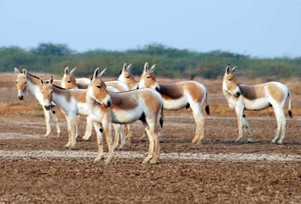Description

Disclaimer: Copyright infringement not intended.
Context: A division bench of the Gujarat High Court Wednesday issued a notice to the state government and sought a report from it on the licences and permissions it has granted for mining activities within Wild Ass Sanctuary in the Little Rann of Kutch. The Court issued the notice while hearing a public interest litigation (PIL) on ‘illegal’ salt mining and mineral mining activities in the sanctuary.
Details:
Rann of Kachchh:
- The people of western India calls desert as "the Rann" which means barren land with no productivity or the remnants of a destroyed land.
- The Rann of Kachchh is "a desolate area, sun baked and saline clay desert shimmering with the image of perpetual mirage".
- The Rann of Kachchh is divided into two parts known as Great Rann of Kachchh (GRK) and Little Rann of Kachchh (LRK).
.jpeg)
About the sanctuary:
- Located in an area called Little Run of Kutch, the Wild Ass Sanctuary in Kutch is the only home to wild ass in India.
- The sanctuary was set up in 1973 with a purpose to protect the endangered Indian wild ass.
- Sprawling over an area of 5000 square kilometers of the Little Rann and covering a minor portion of the cities like Sundernagar, Rajkot, Patan, Banaskantha and Kutch district, the wild ass sanctuary is the largest wildlife sanctuary in Gujarat.
- Also, the sanctuary is home to a sizeable population of Rabari and Bharwad tribes.
About Wild Ass:
- Indian Wild Ass (Equus hemionus khur), commonly known as the ghudkhar, still exists in this sanctuary.
- Akin to the Tibetan kiang, the ghudkhar are distinguished by a dark stripe along its back.
- Known for its speed, the wild ass lives in herds led by stallions and survived by migrating between the grassy 'bets' through the season, in search of food.
- There are around 3000 wild asses in the sanctuary and can be best seen in and around October and November.
- The Indian wild ass is considered as a flagship species in LRK to conserve the biodiversity of the landscape.
- IUCN gave Indian Wild Ass Endangered status and it is protected as Schedule-I species under Wildlife Protection Act (1972).
- The Indian Wild Ass is a strong and majestic animal whose range once extended from Southern India towards southern Pakistan (i.e. provinces of Sindh and Baluchistan), Afghanistan and south-eastern Iran.
- Now, we have world’s last population of Indian Wild Ass restricted within their last refuge of Indian desert called Rann of Kachchh.
- Indian Wild Ass is a generalist grazer which predominantly feeds on grasses but during summer when grasses are scanty and dried they used to feed on Prosopis pods and leaves.

Worldwide species:
- There are three species of wild ass, one in Africa and two in Asia (Equus hemionus and E. kiangs).
- Two species of Asian wild asses are further classified into eight surviving subspecies i.e. five of E. hemionus and three of E. kiangs.
- Ten surviving subspecies of wild asses (eight Asian and two African) are in different stages of endangerment.
Ecological Importance:
- The population trend of Indian wild ass is significant to know the condition of its habitat.
- Indian wild ass is predominantly a grassland species which mainly feeds on grasses.
- To maintain a healthy population we need to ensure its habitat in prosperous condition. It’s a measure which could help us in protecting other grassland species like rodents, small birds, etc. The uniqueness of LRK is surprising to witness during monsoon.
- This is the time when the entire Rann area stays inundated for 2 to 3 months and the highlands inside the vast mud flat terrain become the breeding ground for Indian wild ass.
- And these highlands which are called "beyt" are ecologically very important towards the breeding population of Indian wild ass and migratory birds and many other species which take shelter in those beyts. Thus we can call Indian wild ass as the "Guardian of the Rann".

Other fauna:
- Other than the wild ass, the sanctuary is home to 32 other type of mammals including chinkara(Indian gazelle), two types of Desert Fox (Indian and White-footed), Jackals, Caracals, Nilgais (the largest antelope of Asia), Indian Wolves, Blackbucks, and Striped Hyenas.
- The sanctuary is also refugee to some migratory birds like Sandgrouses, Desert Wheatears, Ten Species of Lark, the White-Browed Bulbul, Indian Coursers, Stoneplovers, Shrikes, Ducks, Geese, Ibis, Spoonbills, Godwits, Stints, Sandpipers, Shanks, Moorhens, Saras Cranes, both Indian Flamingoes, and Pelicans.
|
PRACTICE QUESTION
Q) Indian Wild Ass is known as the guardians of Rann. Comment. (150 words)
|

https://indianexpress.com/article/cities/ahmedabad/hc-seeks-report-gujarat-govt-mining-leases-wild-ass-sanctuary-8499102/












